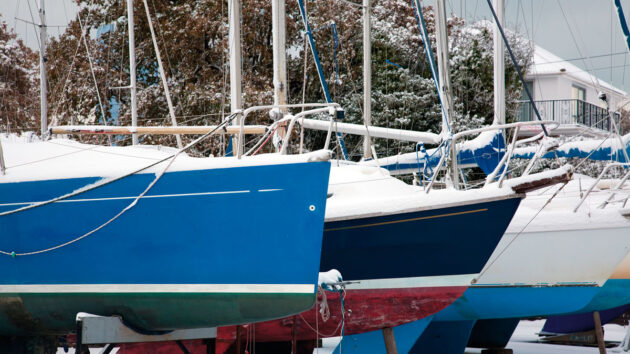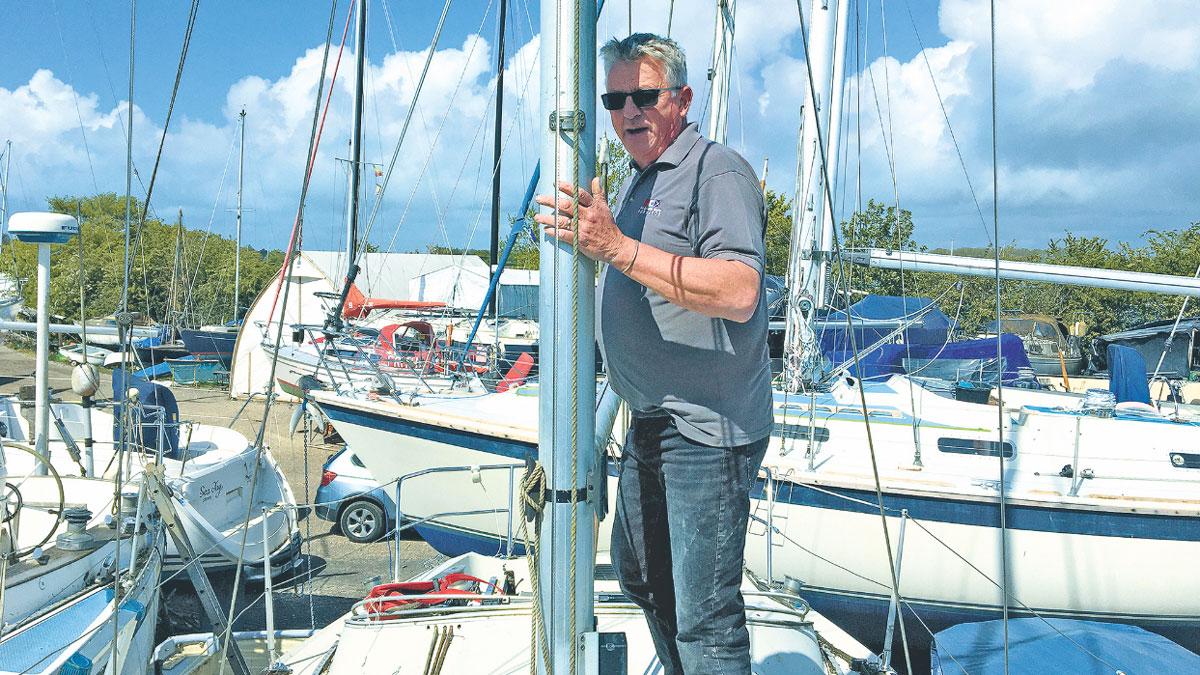Preventative fixes to help save your boat from ice or water damage can be done in just minutes, says Ben Sutcliffe-Davies
February, on average, is the coldest month of the year in the UK and, even with the unpredictability of our weather, there’s no reason to believe this year will be any different.
For owners who took their boats out of the water, their experiences largely depended on how they protected their craft.
My home marina is in South Wales and the ice and snow that the area experienced may have been a wake-up call for a number of insurance companies and boat owners as well as for me.
Many people left their craft in the water – me included.
We were frozen in, with ice more than 50mm thick, for more than a week!
Lulling us into a false sense of security, our winters had been very mild for years so the prospect of taking the kids out on the boat on a sunny winter’s day sounded fun.

Inadequate sealing on even minor deck fittings can let water into cored GRP decks – when it freezes that can lead to delamination and rot
When the ice was packing around the waterline, however, I began to think I’d made a poor decision.
For some owners it clearly was: several had left their boat’s skin fittings open and water froze in the pipes, splitting the hoses.
If you leave your boat afloat in a frozen sea with the skin fittings open you’re asking for trouble, especially when the thaw comes. The results can be devastating.
Even out of the water you have to take precautions.
In the past, I have always taken my boat out of the water around the middle to end of October and properly winterised her as my father taught me.
This involves draining off water tanks and hoses – not forgetting the heads – and running antifreeze through the engine’s water system.

Water left in this mixer tap has frozen and blown the tap apart, leading to water damage
We do the engine flush with an old bucket with a hose coming out of the bottom, hung over the exhaust outlet with the hose connected to the engine’s water inlet.
The bucket is filled with 50% antifreeze and 50% water.
To protect her from the bad weather I always remove the mast and put a decent hard-backed frame over her with wooden battens on the guard rails, and a good heavy canvas cover with plenty of ventilation.
Lastly, I make sure the craft is well propped up with the props all braced together and the hull well supported at the right places.
This is especially important with GRP craft.
I can still vividly remember seeing a marina yard in Suffolk with whole lines of yachts that had been blown over by the winter gales – it looked as though a child had been having fun knocking over dominoes.
Tips from a surveyor to avoid ice and water damage
In my capacity as a surveyor, I had to examine a yacht last winter that was up for sale, and its poor state made me realise how complacent many of us had become in winterising our craft.
Frozen water tanks, solid water in the bowl of the heads and taps blown off were just the first signs of the numerous problems caused by the cold snap.
If boats are just taken out of the water and the engines not properly winterised, you may find the head cracks at the water jacket, core plugs can pop out of the block (they’re designed to do this) or the block itself can crack.

This cracked engine block is due to insufficient antifreeze in the coolant
Likewise, any water system hoses may have blown off or burst, as can happen to uninsulated water pipes in the loft of your house.
If you don’t conduct a proper check it may only be once the craft is launched that such problems are discovered – and that could prove expensive.
Another frequently overlooked area is the vessel’s construction.
GRP boats utilise different methods of stiffening the deck and cockpit areas, but a large number rely on balsa or foam sandwich systems.

A good cover protects against bad weather, but needs plenty of ventilation
Both are good core materials, but need to be kept dry: when surveying I am often amazed at how many owners screw minor fittings for boat hooks and the like to the deck without sufficient sealant or proper support, allowing water to slowly penetrate the moulding.
I use a moisture meter on the underside of the decks and this soon finds areas of moisture ingress.
High moisture content invariably means trapped water: when this turns to ice, even a small expansion can seriously damage a deck.
My advice on ice or water damage is simple – prevention is always easier than cure.

Split grommets and poor seals around cable entries can let water in which will then freeze and cause more damage
If you don’t take reasonable steps to protect your boat you may even find you aren’t covered by your insurance.
Try to get into a good routine of winterisation, but don’t regard laying up as the end of the job: pre-launch checks are just as important.
Before relaunching, make sure the basic systems are all working, check deck fittings are well bedded, sealed and secure, and make sure your water tank is watertight and all the hoses are intact.
Clamps around skin fittings should be in good order, and make sure that all water valves will fully open and shut.

This split water jacket will have been caused by insufficient antifreeze in the coolant
Don’t hesitate to use some waterproof grease around the moving parts of the fitting.
Fuel filters should be replaced and any water build-up in the fuel tank removed.
Make sure the engine is working properly, and that no water is obvious in the oil.
Lastly, if shore power is available the cost of running a small heater on a thermostat is negligible compared to the cost of having to make major repairs – it’s a very prudent investment!
Osmosis on a boat: will it cause my vessel to sink?
Katy Stickland talks to surveyor Ben Sutcliffe-Davies about why osmosis can be an indicator of high moisture content in fibreglass
How to get the most from your yacht survey
Thinking of buying a new boat? A marine survey could save you a lot of heartache and money in the…
15 boat fixes at sea: sailors share how to deal with torn sails, rudder damage, chafe & more
Transatlantic sailors tell Ali Wood how they used their ingenuity – and sometimes bravery – to cope with emergencies on…
Boat maintenance: jobs to tackle over the winter
Now’s the time to tick-off those jobs you’ve been putting off all season and get a head-start on the spring…
Want to read more practical articles like Is your boat fit for a cold snap?

A subscription to Practical Boat Owner magazine costs around 40% less than the cover price.
Print and digital editions are available through Magazines Direct – where you can also find the latest deals.
PBO is packed with information to help you get the most from boat ownership – whether sail or power.
-
-
-
- Take your DIY skills to the next level with trusted advice on boat maintenance and repairs
- Impartial in-depth gear reviews
- Practical cruising tips for making the most of your time afloat
-
-
Follow us on Facebook, Instagram, TikTok and Twitter








